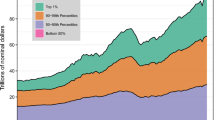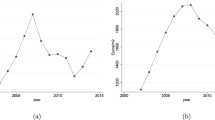Abstract
The present research covering the latest residential boom and bust cycle highlights the lack of uniform or constant time invariant wealth, housing and income relations. More important, wealth composition is shown to be a significant determinant of consumption. The marginal effects of housing equity, financial wealth and income differ substantially based on the composition of household wealth. Households with the highest percentage of net worth in financial assets have much lower income effects, have substantially higher marginal effects associated with stock holdings and have housing equity effects that differ noticeably from other households. Income effects for groups with the smallest amounts of relative financial wealth are dramatically higher than for households with greater financial wealth. Wealth and its composition affect consumption.
Similar content being viewed by others
Notes
Of note, many regulatory standards specifically exclude housing equity in determining the suitability of an investment. Also, the major wealth management firms exclude housing when determining investable wealth. While these firms earn fees from the management of financial assets, the distinction between the two types of wealth by financial professionals is prevalent and implies a difference in asset characteristics.
A major issue that has impacted the assessment of these effects is limited data on consumption. Like in prior studies this limitation is acknowledged.
Muellbauer (2007) makes a related argument that higher loan-to-value ratios increase consumption. Again, higher debt allows retention of cash for consumption.
PSID is a nationally representative sample of U.S. households starting from 1968 with over 18,000 individuals living in 5000 families. It is of longitudinal nature in design, but cross-sectionally also representative. Since 1999, PSID has switched from annual surveys to biennial ones. Furthermore, prior to 1999, wealth information is only solicited once every five years.
In our model and data, we have not considered the fractions in riskless savings deposits, thus observations are not exactly switched off in classification tiers based on the ratio of stock holdings versus that of housing equity.
Direct comparisons of the 90 to 100 %, 80 to 90 %, 70 to 80 %, and 0 to 70 % stock holdings as a percentage of net worth household groups as well as comparisons of the households segmented based on ratio of home equity to net worth from 0 to 10 %, 10 to 20 %, 20 to 30 %, and 30 to 100 % provide complementary and confirmatory results as well. The households with the largest portion of net worth in financial assets (the 90 to 100 % group in the first measure and 0 to 10 % group in the second measure) have statistically significant and large coefficients indicative or a greater impact of stocks on consumption. For example, the coefficient of the stock holdings variable for the 0 to 10 % home equity to net worth group is 0.0436 (and significant at the 1 % level), while the coefficients for the other three groups in order are 0.0068, −0.0187, and 0.0020, respectively and are not statistically significant.
References
Belsky, E., & Prakken, J. (2004). Housing wealth effects: housings impact on wealth accumulation, wealth distribution, and consumer spending. National Center for Real Estate Report W04-13. Harvard University, Boston. http://www.jchs.harvard.edu/publications/finance/w04-13.pdf.
Benjamin, J. D., & Chinloy, P. (2008). Home equity, household savings and consumption. Journal of Real Estate Finance and Economics, 37(1), 21–32.
Benjamin, J. D., Chinloy, P., & Jud, G. D. (2004a). Real estate versus financial wealth in consumption. Journal of Real Estate Finance and Economics, 29(3), 341–354.
Benjamin, J. D., Chinloy, P., & Jud, G. D. (2004b). Why do households concentrate their wealth in housing? Journal of Real Estate Research, 26(4), 329–343.
Bhatia, K. B. (1987). Real estate assets and consumer spending. Quarterly Journal of Economics, 102(2), 437–444.
Bostic, R., Gabriel, S., & Painter, G. (2009). Housing wealth, financial wealth, and consumption: new evidence from micro data. Regional Science and Urban Economics, 39(1), 79–89.
Campbell, J. Y., & Cocco, J. (2007). How do house prices affect consumption? Evidence from Micro data. Journal of Monetary Economics, 54(3), 591–621.
Carroll, C. D., Otsuka, M., & Slacalek, J. (2011). How large is the housing wealth effect?: a new approach. Journal of Money, Credit, and Banking, 43(1), 55–79.
Case, K., Quigley, J., & Shiller, R. J. (2005). Comparing wealth effects: the stock market versus the housing market. Advances in Macroeconomics, 5, Article 1.
Elliot, J. W. (1980). Wealth and wealth proxies in a permanent income model. Quarterly Journal of Economics, 95(3), 509–535.
Engelhardt, G. V. (1996). House prices and home owner saving behavior. Regional Science and Urban Economics, 26(3–4), 313–336.
Englund, P., Hwang, M., & Quigley, J. M. (2002). Hedging housing risk. Journal of Real Estate Finance and Economics, 24(1–2), 167–200.
Flavin, M., & Nakagawa, S. (2008). A model of housing in the presence of adjustment costs: a structural interpretation of habit persistence. American Economic Review, 98(1), 474–495.
Flavin, M., & Yamashita, T. (2002). Owner-occupied housing and the composition of the household portfolio. American Economic Review, 92(1), 345–362.
Flavin, M., & Yamashita, T. (2011). Owner-occupied housing: life-cycle implications for the household portfolio. American Economic Review, 101(3), 609–614.
Goodman, A. C., & Kawai, M. (1982). Permanent income, hedonic prices, and demand for housing: new evidence. Journal of Urban Economics, 12(2), 214–237.
Grossman, S. J., & Laroque, G. (1990). Asset pricing and optimal portfolio choice in the presence of illiquid durable consumption goods. Econometrica, 58(1), 25–51.
Iacoviello, M., & Ortalo-Magne, F. (2003). Hedging housing risk in London. Journal of Real Estate Finance and Economics, 27(2), 191–209.
Kishor, N. K. (2007). Does consumption respond more to housing wealth than to financial market wealth? If so, why? Journal of Real Estate Finance and Economics, 35(4), 427–448.
Koo, H. K. (1998). Consumption and portfolio selection with labor income: a continuous time approach. Mathematical Finance, 8(1), 49–65.
Kraft, H., & Munk, C. (2011). Optimal housing, consumption, and investment decisions over the life cycle. Management Science, 57(6), 1025–1041.
Lehnart, A. (2003). Housing, consumption, and credit constraints. Board of Governors of the Federal Reserve System.
Lettau, M., & Ludvigson, S. (2004). Understanding trend and cycle in asset values: reevaluating the wealth effect on consumption. American Economic Review, 94(1), 276–29.
Muellbauer, J. N. (2007), Housing, credit, and consumer expenditure. Housing, Housing Finance, and Monetary Policy, Conference Proceedings, Federal Reserve Bank of Kansas City.
Skinner, J. (1989). Housing wealth and aggregate saving. Regional Science and Urban Economics, 19(2), 305–324.
Skinner, J. S. (1996). Is housing wealth a sideshow? Advances in the economics of aging. National Bureau of Economic Research Report (pp. 241–268). Chicago: University of Chicago Press.
Slacalek, J. (2009). What drives personal consumption? The role of housing and financial wealth. B. E. Journal of Macroeconomics, 9, article 37.
Stokey, N. L. (2009). Moving costs, nondurable consumption and portfolio choice. Journal of Economic Theory, 144(6), 2419–2439.
Author information
Authors and Affiliations
Corresponding author
Rights and permissions
About this article
Cite this article
Guo, S., Hardin, W.G. Wealth, Composition, Housing, Income and Consumption. J Real Estate Finan Econ 48, 221–243 (2014). https://doi.org/10.1007/s11146-012-9390-z
Published:
Issue Date:
DOI: https://doi.org/10.1007/s11146-012-9390-z




